25 Best Indoor Plants for Boosting Mood & Purifying Air: Ultimate Guide
- April 19, 2024
- 0 comment
Explore our Ultimate Guide to the 25 Best Indoor Plants for purifying air & enhancing mood. Transform your home into a serene oasis. Discover the 25 best indoor plants that do more than just purify the air — they enhance your mood too. Perfect for both seasoned gardeners and new plant owners, these plants will turn your home into a peaceful retreat.

Featuring lush foliage and vibrant blooms that detoxify your space and add a splash of color, this guide will help you find the ideal plants to create a healthier, more inviting atmosphere. Explore our list and see how these natural wonders can bring peace and beauty to your indoor spaces.
List of 25 Best Indoor Plants
- POTHOS (Epipremnum aureum)
- PHILODENDRON (Philodendron)
- PRAYER PLANT (Calathea)
- DRACAENA (Dracaena marginata)
- ZZ PLANT (Zamioculcas zamiifolia)
- CAST IRON PLANT (Aspidistra elatior)
- LADY PALM (Rhapis excelsa)
- ARECA PALM (Dypsis lutescens)
- PEACE LILY (Spathiphyllum)
- BROMELIAD (Bromeliaceae)
- SWISS CHEESE PLANT (Monstera deliciosa)
- DEVIL’S IVY (Epipremnum aureum ‘Golden Pothos’)
- ORCHID (Phalaenopsis)
- AFRICAN VIOLET (Saintpaulia)
- KIMBERLY QUEEN FERN (Nephrolepis obliterata)
- JADE PLANT (Crassula ovata)
- ALOE VERA (Aloe barbadensis miller)
- BIRD OF PARADISE (Strelitzia reginae)
- ENGLISH IVY (Hedera helix)
- FLAMING KATY (Kalanchoe blossfeldiana)
- SPIDER PLANT (Chlorophytum comosum)
- OLEANDER (Nerium oleander)
- CHRISTMAS CACTUS (Schlumbergera)
- DWARF CITRUS (Citrus)
- CROWN OF THORNS (Euphorbia milii)
Understanding Indoor Air Quality and Mood Improvement
Basics of Indoor Air Quality
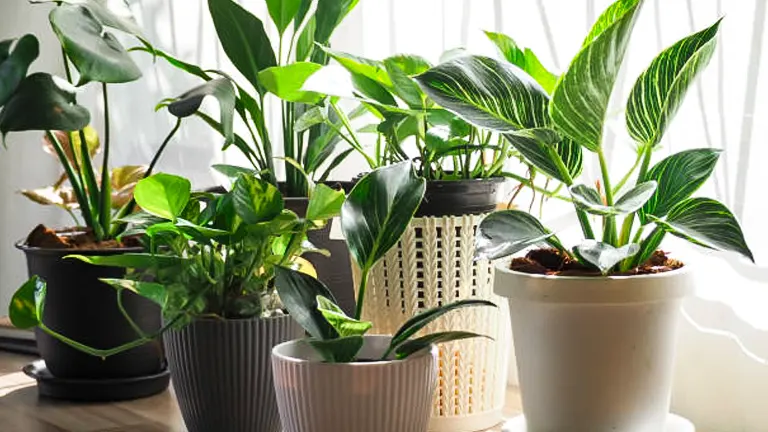
Indoor air quality is influenced by various pollutants including volatile organic compounds (VOCs) emitted from paints, furniture, and cleaning products, as well as carbon monoxide and nitrogen dioxide from indoor heating processes. Common indoor pollutants also include biological pollutants like molds and pollen which can deteriorate the air quality and potentially cause health issues.
How Plants Help
Plants improve indoor air quality through a process known as phytoremediation. This involves absorbing pollutants through their leaves and roots—the plants then process these toxins and release clean oxygen back into the air. Studies, including NASA’s Clean Air Study, have demonstrated that certain plants are particularly effective at absorbing common pollutants like formaldehyde, benzene, and ammonia.
Mental Health Benefits
Beyond purifying the air, plants can have a profound effect on a person’s mood and mental health. The presence of greenery indoors reduces stress, enhances productivity and focus, and promotes an overall sense of well-being. The psychological benefits are supported by research that shows environments with plants have lower levels of anxiety, higher attentiveness, and improved memory retention.
Criteria for Selecting the Best Indoor Plants
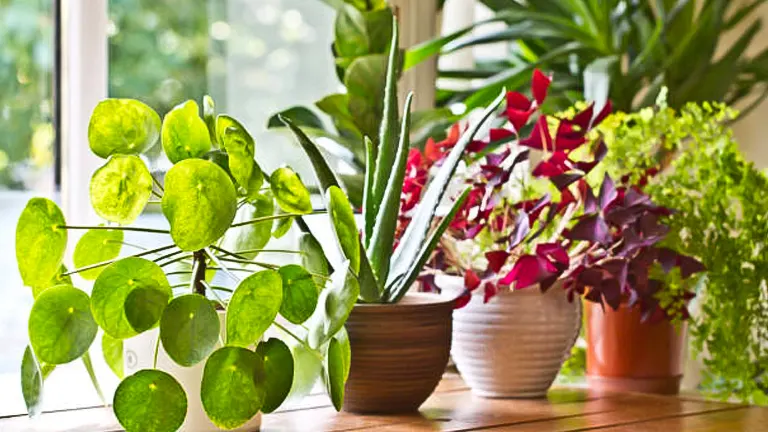
Choosing the right indoor plants involves more than just picking out the most visually appealing ones. Here are the criteria that helped shape our list of the top 25 mood-boosting and air-purifying plants:
Air-Purifying Abilities
A plant’s ability to filter the air is paramount. The best plants for air purification excel in absorbing not just carbon dioxide but also harmful chemicals and particulates from the air, which can lead to cleaner breathing environments.
Mood-Boosting Qualities
Plants that are effective at improving mood often have vibrant colors and dynamic shapes that can subtly enhance psychological well-being and indoor aesthetics. Additionally, the act of caring for a plant—such as watering and pruning—can itself be a therapeutic activity that reduces stress.
Ease of Care
For maximum benefits, it’s important to select plants that are low-maintenance. These plants should thrive in indoor conditions with minimal watering, light, and fertilizer requirements.
Light Requirements
Understanding a plant’s light needs is crucial for ensuring it thrives in your home. The light requirement for each plant falls into one of three categories:
- Low Light: Ideal for north-facing windows or areas along interior walls. While these plants tolerate low light and grow slower, they might perform better under slightly brighter conditions.
- Medium/Bright, Indirect/Filtered Light: Best for east-facing windows, or south- or west-facing windows covered by sheer curtains, or positioned 3 to 5 feet away from these windows. These plants thrive under gentle but bright light without direct sun exposure.
- Bright/High Light: Suitable for south- or southwest-facing windows without any obstructions. These plants require abundant light to grow well and are ideal for spots receiving direct sunlight.
Best Indoor Plants for Low Light
POTHOS (Epipremnum aureum)

- Size: Vines can grow 6 to 10 feet long.
- Water: Allow the top inch of soil to dry out before watering again.
- Fertilize: These are light feeders. Use a balanced liquid fertilizer every 1 to 3 months depending on growth.
Pothos is one of the most low-maintenance and versatile houseplants available, making it perfect for beginners. This tropical vine thrives in low light conditions and offers a variety of leaf colors and patterns. Its hardiness and the ability to purify air make it an ideal choice for home environments. Pothos can be kept compact through regular trimming, allowed to trail beautifully from hanging baskets, or even trained up vertical structures to add a lush, green touch to your decor. Regular pruning not only keeps it manageable but also promotes fuller growth.
PHILODENDRON (Philodendron)
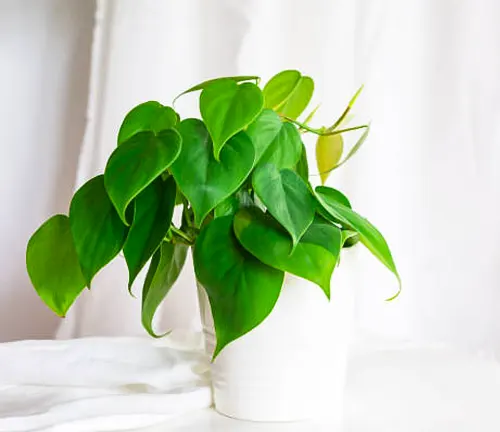
- Size: Vines up to 8 feet long.
- Water: Prefers evenly moist soil; water when the top inch of soil feels dry.
- Fertilize: Feed with a water-soluble houseplant fertilizer from spring to fall.
Philodendron plants are renowned for their tolerance to low-light conditions, making them another excellent choice for indoor gardeners. Like pothos, philodendrons are easy to care for, growing quickly in medium to bright light but also faring well in darker corners. They come in various sizes and shapes, which allows for decorative flexibility—whether you want a hanging basket or a climbing plant. Outdoor growing is also possible in mild climates, providing a versatile option for year-round greenery.
PRAYER PLANT (Calathea)
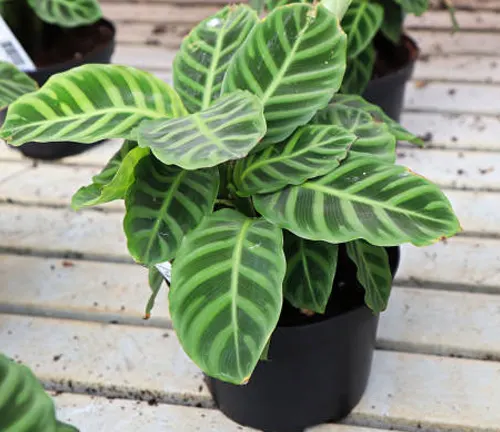
- Size: Typically grows up to 3 feet tall.
- Water: Maintain evenly moist soil—neither soggy nor dry. May require distilled or filtered water, as it can be sensitive to tap water minerals.
- Fertilize: Fertilize monthly from spring through fall.
Prayer Plants are celebrated for their strikingly patterned foliage which can include shades of green, white, pink, and even deep red. These plants are ideal for low light and high humidity environments, making them perfect for bathrooms or kitchens. The unique patterns on their leaves close up at night, which is where their common name comes from. Due to their sensitivity, they should not be repotted often and prefer to be slightly root-bound. Along with their visual appeal, prayer plants can also improve air quality, making them a functional and beautiful addition to any indoor space.
DRACAENA (Dracaena marginata)
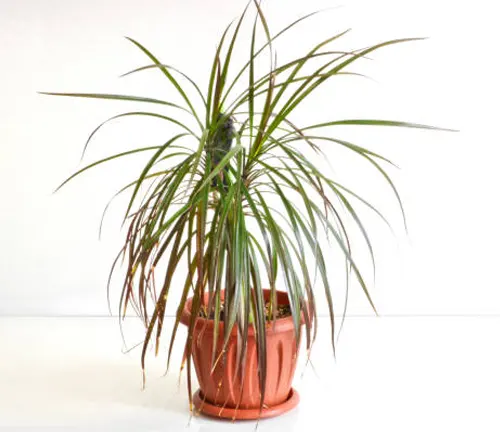
- Size: Can grow up to 6 feet tall.
- Water: Allow the soil to dry between waterings.
- Fertilize: Feed with liquid fertilizer every month during the spring and summer.
Dracaenas are excellent for low-light conditions and add a dramatic touch with their long, narrow leaves, which are often edged with red or yellow. Known as the Dragon Tree, Dracaena helps remove pollutants like benzene, trichloroethylene, and formaldehyde from indoor air. This plant is quite resilient and can add vertical interest to a dim corner of any room.
ZZ PLANT (Zamioculcas zamiifolia)
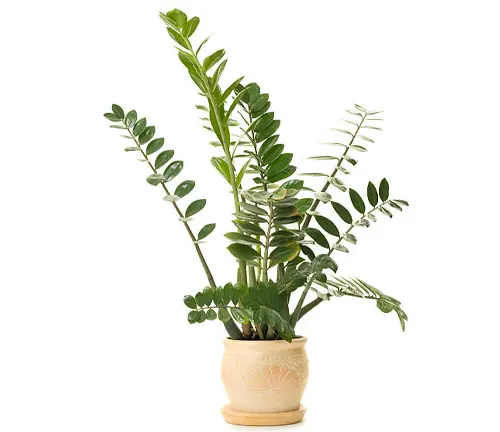
- Size: Typically grows up to 3 feet tall.
- Water: Water only when the soil is dry.
- Fertilize: Minimal feeding; use a balanced fertilizer a few times a year.
The ZZ Plant stands out with its waxy, lush leaves that are able to thrive in low light conditions. It is extremely drought-tolerant and perfect for locations where other plants might not survive. Besides improving air quality, the ZZ Plant is known for its durability and ease of care, making it ideal for busy or forgetful gardeners.
CAST IRON PLANT (Aspidistra elatior)
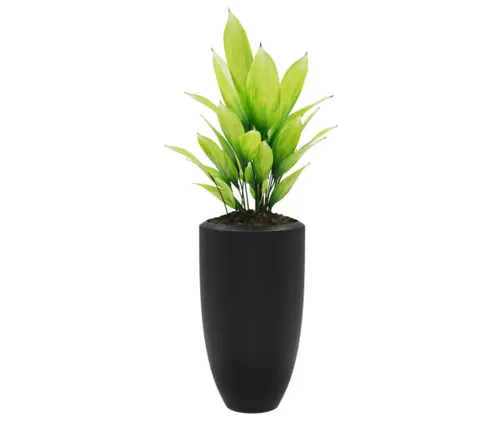
- Size: Grows up to 2 feet tall.
- Water: Water moderately, allowing the soil to dry out slightly between waterings.
- Fertilize: Fertilize sparingly, only a couple of times a year.
The Cast Iron Plant earns its name from its nearly indestructible nature. Ideal for low light and varying conditions, it can survive with minimal water and care. Its broad, dark green leaves provide a lush, minimalist aesthetic. This plant is particularly valued for its ability to grow where other plants might not.
LADY PALM (Rhapis excelsa)
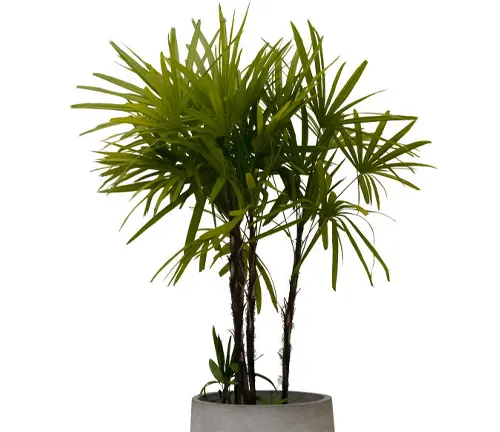
- Size: Can grow up to 4 feet tall.
- Water: Keep the soil consistently moist.
- Fertilize: Feed with a balanced liquid fertilizer every month during the growing season.
Lady Palm is perfect for low-light conditions and known for its air-purifying capabilities. It features fan-like leaves and can significantly improve indoor air quality by removing toxins such as ammonia. It adds a sophisticated touch to any space and is relatively easy to maintain, making it ideal for offices and homes alike.
Best Indoor Plants for Medium/Bright, Indirect/Filtered Light
ARECA PALM (Dypsis lutescens)

- Size: Can grow up to 6-7 feet tall.
- Water: Keep soil evenly moist throughout the year.
- Fertilize: Use a palm-specific fertilizer every few months during the growing season.
The Areca Palm features feathery, arching fronds and is best suited for bright, indirect light. It not only adds a tropical flair but also humidifies the air and removes toxins. This palm is perfect for creating a statement in living rooms or offices with its elegant and airy fronds.
PEACE LILY (Spathiphyllum)
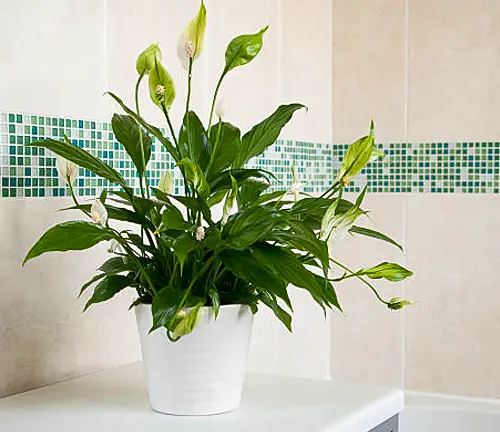
- Size: Can grow up to 3-4 feet both in height and width.
- Water: Keep the soil consistently moist.
- Fertilize: Feed lightly with a balanced fertilizer every month during spring and summer.
The Peace Lily is a striking plant with glossy leaves and white, hood-like flowers that emerge periodically. It excels in medium to bright, indirect light and significantly improves indoor air quality by removing common toxins. This plant is also known for its ability to increase room humidity, which helps decrease airborne microbes.
BROMELIAD (Bromeliaceae)
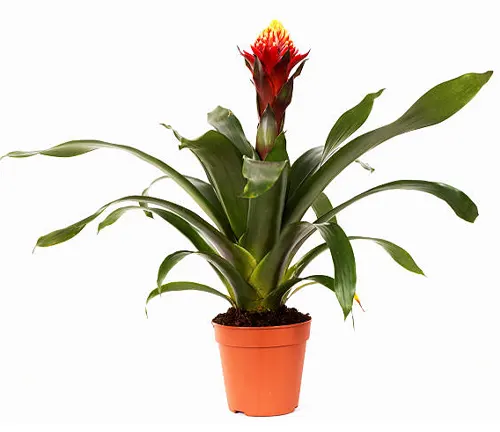
- Size: Generally around 1-3 feet tall.
- Water: Water the central cup; mist occasionally.
- Fertilize: Light feeding during the growing season.
Bromeliads are colorful and easy to care for, thriving in indirect light. They have a unique watering requirement where the central cup should be kept filled with water. Known for their striking, vibrant colors, Bromeliads can add a decorative touch to any indoor space.
SWISS CHEESE PLANT (Monstera deliciosa)
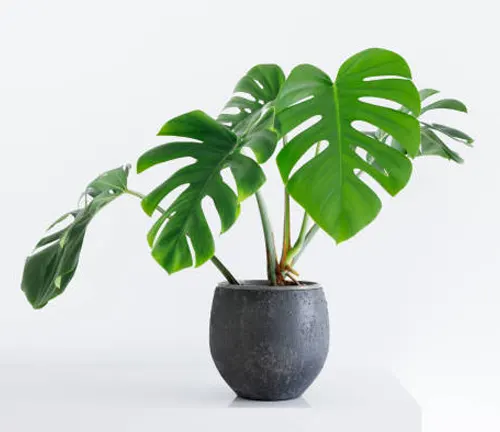
- Size: Can grow up to 8 feet tall.
- Water: Water every 1-2 weeks, allowing soil to dry out between waterings.
- Fertilize: Use a general-purpose liquid houseplant fertilizer every month during spring and summer.
The Swiss Cheese Plant is loved for its distinctive leaf patterns, where the leaves develop natural holes, earning it the name. It prefers bright, indirect light but can tolerate lower light levels. This plant not only purifies the air but also adds an exotic and tropical feel to any room.
DEVIL’S IVY (Epipremnum aureum ‘Golden Pothos’)

- Size: Vines can grow over 8 feet long.
- Water: Allow the top inch of soil to dry out before watering.
- Fertilize: Apply a balanced liquid fertilizer monthly in spring and summer.
Devil’s Ivy, also known as Golden Pothos or just Pothos, is almost indestructible and can thrive in a variety of lighting conditions, though it prefers medium to bright, indirect light. It’s excellent for beginners and effective at removing indoor pollutants like formaldehyde and benzene.
ORCHID (Phalaenopsis)
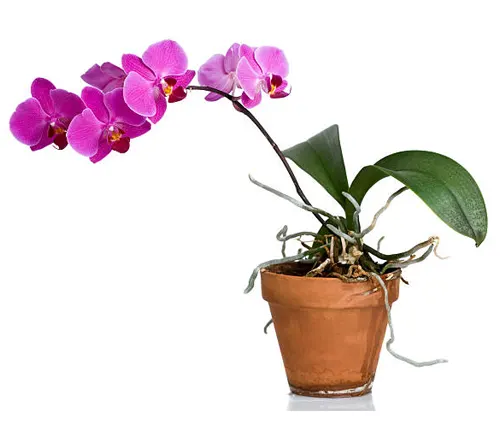
- Size: Typically up to 2 feet tall.
- Water: Water weekly during the growth period, less frequently in winter.
- Fertilize: Feed with a balanced fertilizer once a month during spring and summer.
Orchids are exquisite and exotic, making them a popular choice for household floral displays. Phalaenopsis orchids thrive in bright, indirect light and can bloom for months with proper care. They’re not only beautiful but also beneficial for improving indoor air quality.
AFRICAN VIOLET (Saintpaulia)

- Size: Generally under 1 foot in height and width.
- Water: Keep soil consistently moist, use room-temperature water.
- Fertilize: Feed with a high-phosphorus formula every two weeks.
African Violets are small and charming with deep green, fuzzy leaves and lovely violet, pink, or white flowers. They prefer medium to bright, indirect light and can bloom several times a year with the right care regimen, adding a splash of color to any indoor setting.
KIMBERLY QUEEN FERN (Nephrolepis obliterata)
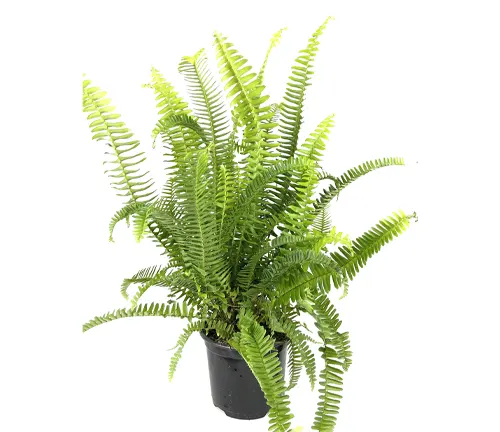
- Size: Typically grows about 3 feet tall and wide.
- Water: Keep the soil moist, especially in dry conditions.
- Fertilize: Feed with a fern-specific fertilizer every two months during the growing season.
Kimberly Queen Fern is an elegant plant with upright sword-like fronds, known for its robust air-purifying properties. It thrives in medium to bright, indirect light and doesn’t tolerate low light well. This fern is particularly effective at removing indoor air pollutants such as formaldehyde and xylene. Its upright growth makes it a perfect addition for corners or alongside furniture.
Best Indoor Plants for Bright/High Light
JADE PLANT (Crassula ovata)
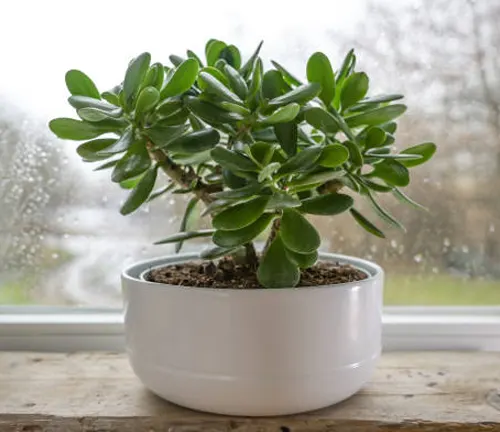
- Size: Can grow up to 3-4 feet tall.
- Water: Water when the soil is dry to the touch; less watering in the winter.
- Fertilize: Feed every few months with a succulent fertilizer.
The Jade Plant is a popular succulent known for its thick, woody stems and oval-shaped leaves, which may develop a red tinge at the edges under sufficient light. It prefers full sun and can be placed in a south-facing window where it receives ample light. The Jade Plant is not only easy to care for but also benefits the indoor environment by absorbing toxins such as toluene and benzene.
ALOE VERA (Aloe barbadensis miller)

- Size: Up to 2 feet tall.
- Water: Water deeply but infrequently, allowing the soil to dry at least 1 to 2 inches deep between waterings.
- Fertilize: Feed with a phosphorus-heavy, water-based fertilizer once every three months during the growing season.
Aloe Vera is renowned for its medicinal properties, especially in healing burns and cuts. It thrives in bright light and can be placed in direct sunlight. Besides its health benefits, Aloe helps remove formaldehyde from the air and is an easy-to-maintain plant that adds a functional yet decorative touch to any sunny indoor space.
BIRD OF PARADISE (Strelitzia reginae)
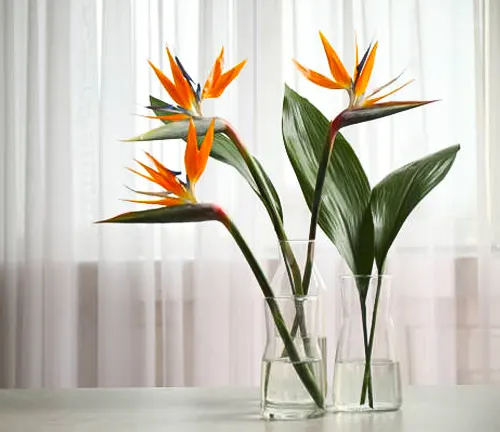
- Size: Can reach over 5-6 feet tall.
- Water: Keep the soil consistently moist in the summer, reducing watering in winter.
- Fertilize: Use a high-potassium fertilizer every two months during spring and summer.
The Bird of Paradise is a stunning tropical plant that flourishes in bright light, often near large windows where it can receive plenty of sunlight. Its large, broad leaves resemble those of a banana plant, and under ideal conditions, it may produce spectacular flowers that resemble birds in flight. This plant not only enhances the aesthetics of any room but also improves the air quality, making it a popular choice for bright indoor areas.
ENGLISH IVY (Hedera helix)
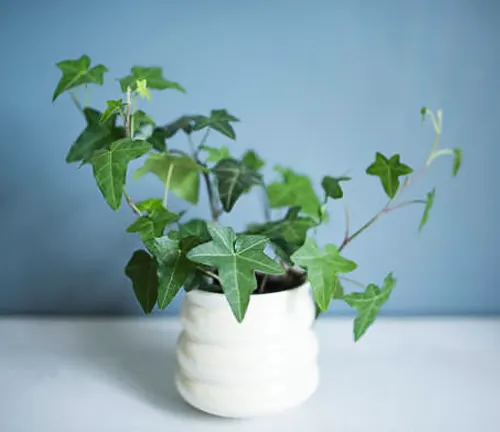
- Size: Vines can grow up to 50 feet long, but indoors usually kept much shorter.
- Water: Maintain evenly moist soil; do not let dry out completely.
- Fertilize: Feed with a balanced liquid fertilizer every month during the growing season.
English Ivy, a classic and elegant vine, thrives in bright light conditions and can be trained along trellises or allowed to hang freely from baskets. Known for its ability to significantly reduce airborne mold and fecal-matter particles, it’s especially beneficial in homes needing allergen control. While it prefers bright light, it can tolerate medium light, making it versatile for various indoor settings.
FLAMING KATY (Kalanchoe blossfeldiana)
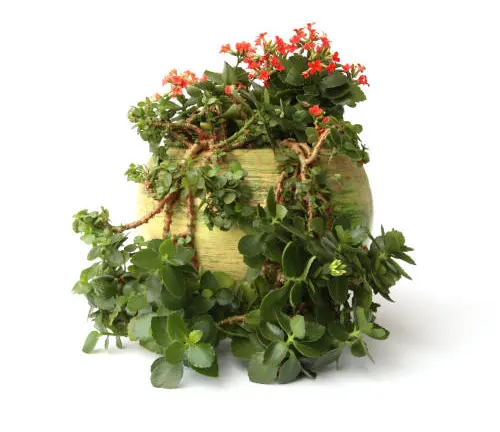
- Size: Generally around 1 foot tall and wide.
- Water: Allow the soil to become dry between waterings.
- Fertilize: Fertilize monthly during the growing season with a balanced fertilizer.
Flaming Katy is a succulent that thrives in bright light and can tolerate sunny conditions. It’s known for its vibrant flowers, which come in red, orange, yellow, and pink. This plant is particularly easy to care for, requiring minimal watering and feeding, making it great for sunny indoor areas.
SPIDER PLANT (Chlorophytum comosum)
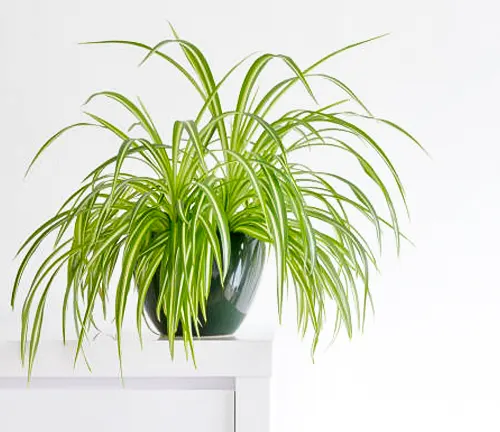
- Size: Can grow about 2-2.5 feet wide with trailing vines.
- Water: Water well but let the soil dry out a bit between waterings.
- Fertilize: Feed occasionally with a general-purpose liquid fertilizer.
Spider Plants are one of the most popular indoor plants for their ease of care and air-purifying abilities. They prefer bright, indirect light but will tolerate levels down to medium light. They are known for their arching leaves and small white flowers, and they can also help remove pollutants such as formaldehyde and xylene from the air.
OLEANDER (Nerium oleander)
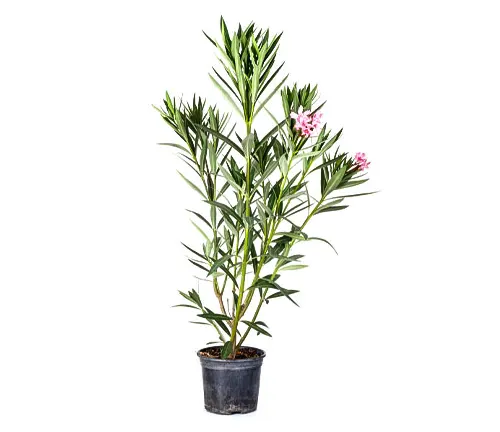
- Size: Can grow up to 6 feet indoors.
- Water: Water when the top inch of soil is dry; reduce watering in winter.
- Fertilize: Use a balanced fertilizer every few months during the growing season.
Oleander is a robust flowering shrub that does well in high light and can be kept indoors with the right care. It produces beautiful blooms in shades of pink, red, and white throughout the summer and fall. Caution should be used as all parts of this plant are toxic if ingested, so it may not be suitable for households with pets or young children.
CHRISTMAS CACTUS (Schlumbergera)
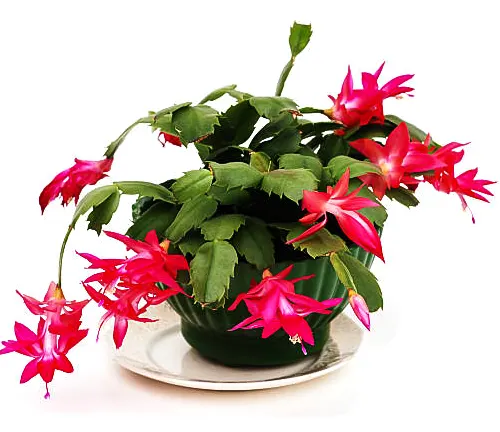
- Size: Typically grows up to 1 foot tall and 2 feet wide.
- Water: Keep the soil moderately moist during growth and blooming.
- Fertilize: Feed with a high-potassium fertilizer every few weeks during the flowering period.
Christmas Cactus is beloved for its beautiful, arching branches covered in colorful, tubular flowers. Thriving in bright to moderate indirect light, this plant is particularly striking during the winter holidays when it usually blooms. It prefers slightly more humid environments and is relatively easy to care for.
DWARF CITRUS (Citrus)
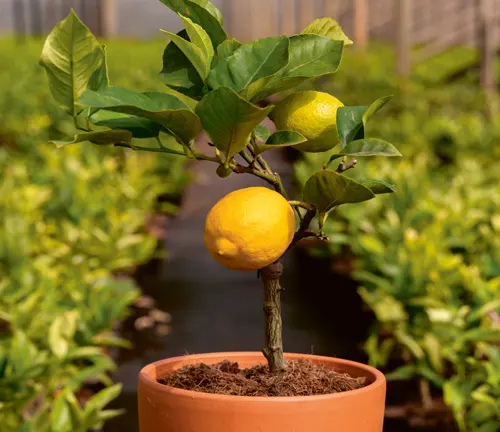
- Size: Ranges from 4 to 12 feet tall when grown indoors.
- Water: Water regularly to keep the soil moist, especially during the warmer months.
- Fertilize: Use a high-nitrogen fertilizer every few weeks during the growing season.
Dwarf Citrus trees, such as lemons, oranges, and limes, are fantastic for bright, sunny spots and add a fresh scent to any room. They require consistent care and plenty of sunlight to thrive and potentially produce fruit. These trees not only beautify the space but also purify the air and can add a touch of tropical flair to your indoor gardening efforts.
CROWN OF THORNS (Euphorbia milii)
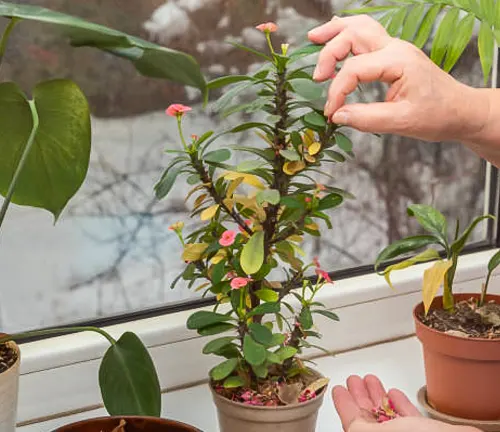
- Size: Can grow up to 3 feet tall.
- Water: Allow the soil to dry completely between waterings.
- Fertilize: Use a cactus fertilizer every two months during the growing season.
Crown of Thorns is a striking plant with vibrant flowers that bloom year-round, provided it gets enough light. It’s suited for bright to high light conditions and requires minimal care, apart from cautious watering practices. The sap of this plant is toxic, and it should be handled with care, particularly around pets and children.
Practical Tips for Growing Indoor Plants

To ensure your indoor plants thrive and continue to purify the air and boost your mood, follow these fundamental care tips:
Watering
- Check Soil Moisture: Always check the top inch of soil for dryness before watering. Over-watering can lead to root rot, which is one of the most common issues faced by indoor plants.
- Water Deeply but Infrequently: It’s better to water thoroughly and less often, allowing water to reach deeper roots and encouraging stronger growth.
- Use Room-Temperature Water: Cold water can shock the plant’s roots, especially tropical varieties. Room-temperature water is more conducive to healthy growth.
Lighting
- Provide Adequate Light: Ensure each plant receives the type of light it needs. This could mean placing some plants near a south-facing window or providing shade with a sheer curtain for others.
- Rotate Plants Regularly: To encourage even growth and prevent plants from leaning towards the light source, rotate your plants a quarter turn with each watering.
Feeding
- Fertilize During the Growing Season: Most indoor plants benefit from regular feeding during spring and summer. Use the right type of fertilizer according to the plant’s specific needs, which is typically a balanced liquid fertilizer diluted to half strength.
- Reduce Fertilizer in Winter: Plants grow more slowly in the cooler months, so reduce feeding in winter to prevent nutrient overload, which can harm your plants.
Pruning and Cleaning
- Prune Regularly: Remove dead or yellowing leaves to keep your plants looking their best and to prevent potential pests and diseases.
- Dust Leaves: Wipe leaves with a damp cloth to remove dust, which can block sunlight and reduce the plant’s ability to photosynthesize.
Pest Control
- Inspect Regularly: Check for signs of pests such as spider mites, mealybugs, and scale. These pests can typically be found on the underside of leaves.
- Natural Remedies: Use natural pest control methods like neem oil or insecticidal soap to treat infestations without harming the plant or the environment.
Incorporating Plants into Home Decor
Indoor plants not only provide health benefits but also enhance the aesthetics of your space. Here’s how to stylishly incorporate them into your home decor:
Choose the Right Planters
- Match Your Decor Style: Select planters that complement your home’s style whether it’s modern, rustic, or traditional. Consistency in planter style can unify the room’s appearance.
- Consider Planter Size and Color: Make sure the planters are large enough to accommodate the plant’s root growth. Using colorful planters can add a vibrant touch to the decor.
Create Groupings
- Vary Plant Heights: Arrange plants of different heights together to create a more layered, textured look. This can make your plant display more visually interesting.
- Use Shelves and Stands: Utilize vertical space by placing plants on different levels using stands or shelves, which is especially effective in smaller spaces.
Use Plants as Design Elements
- Create a Focal Point: Use a large plant like a Fiddle Leaf Fig or a Bird of Paradise as a focal point in a room to draw the eye and anchor the space.
- Enhance Room Dividers: Place tall plants like the Dracaena or Areca Palm in open spaces to act as natural room dividers.
- Softening Corners: Tall, cascading plants like the Devil’s Ivy can soften room corners and add a touch of elegance.
Troubleshooting Common Problems
Even with the best care, plants can sometimes encounter issues. Here are solutions to some common problems:
Yellowing Leaves
- Cause: Over-watering, poor drainage, or insufficient light.
- Solution: Adjust watering habits, ensure good drainage, and move the plant to a brighter location if needed.
Dropping Leaves
- Cause: Usually due to a sudden change in temperature or light.
- Solution: Try to maintain a consistent environment, and avoid placing plants near drafty windows or heat sources.
Pest Infestations
- Cause: Often related to high humidity or over-watering.
- Solution: Reduce humidity around the plant, improve air circulation, and treat with natural pesticides.
Slow Growth
- Cause: Insufficient light, low humidity, or nutrient deficiency.
- Solution: Move the plant to a brighter area, mist the leaves regularly, or feed with a suitable fertilizer.
Related Post
- How to Fertilize a Mango Tree Effectively: Tips and Tricks for Healthy Growth
- How to Fertilize Apple Trees: Essential Tips for a Bountiful Harvest
- How to Fertilize Lemon Trees: Secrets for Thriving Citrus
- How to Fertilize Avocado Tree: A Step-by-Step Guide for Lush Growth
- How to Fertilize Bougainvillea: A Complete Guide for Stunning Blooms
Conclusion
Incorporating indoor plants into your living space can transform your home into a more vibrant, healthier environment. Regardless of your experience level, caring for these natural companions offers numerous benefits, including improved air quality and a personal sense of well-being. By understanding and meeting their basic needs—appropriate lighting, watering, and fertilizing—you’ll ensure they thrive. As you cultivate your indoor garden, you’ll not only enhance the aesthetics of your home but also create a nurturing habitat that supports both your plants’ growth and your own comfort and happiness.
FAQs
- What are the best indoor plants for improving air quality?
Indoor plants like the Snake Plant, Peace Lily, and Spider Plant are highly effective at purifying the air. They absorb toxins like benzene, formaldehyde, and trichloroethylene, which are common in household air. - How do indoor plants enhance mood?
Studies have shown that indoor plants improve mood, reduce stress, and increase productivity. The presence of greenery and the act of caring for plants can create a sense of well-being and connect you to nature, which is calming and therapeutic. - Which indoor plants are easiest to care for?
Plants such as the ZZ Plant, Spider Plant, and Pothos are particularly hardy and easy to care for. They require minimal watering and can thrive in a variety of lighting conditions, making them perfect for beginners. - Can indoor plants really help reduce stress?
Yes, interacting with indoor plants can reduce physiological and psychological stress. The tasks involved in gardening, even on a small scale, can be meditative and soothing, offering a break from the busy pace of modern life. - What should I consider when choosing an indoor plant?
Consider the light requirements and the amount of care needed. Evaluate the light levels available in your home and match them with suitable plants. Also, think about how much time you are willing to dedicate to plant care, including watering, feeding, and pruning. - How often should I water my indoor plants?
Watering frequencies depend on the plant species, the size of the plant, the climate, and the time of year. As a general rule, most indoor plants prefer their soil to be slightly moist. Check the top inch of soil, and if it’s dry, it’s time to water. - Are there indoor plants that require very little light?
Yes, several plants thrive in low light conditions. The Cast Iron Plant, ZZ Plant, and Peace Lily can grow in dimly lit environments and are perfect for rooms with few windows or that are north-facing. - What are the best ways to display indoor plants to enhance my home’s decor?
Use a variety of plant sizes and heights to create an engaging display. Tall plants can be placed on the floor, medium plants on tables or shelves, and small plants in grouped arrangements for visual interest. Hanging plants can also add dimension and draw the eye upward.
Embracing the presence of indoor plants can lead to a harmonious and refreshing living space. As you nurture these greens, they return the favor, purifying your air and uplifting your spirits. May this guide inspire you to create your own indoor oasis. Happy planting!

Benjamin Brooks
Forestry AuthorGreetings! I'm Benjamin Brooks, and my journey over the past 15 years has revolved around the fascinating realms of content creation, expertise in snow clearing, and the intricate world of lumberjacking and landscaping. What began as a simple curiosity about the natural world and heavy machinery has evolved into a passionate profession where my love for crafting words intertwines seamlessly with my lumberjacking and garden skills.













Leave your comment